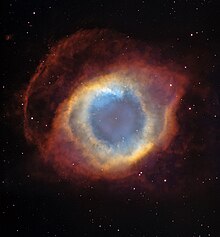

| This article is rated C-class on Wikipedia's content assessment scale. It is of interest to the following WikiProjects: | ||||||||||||||
| ||||||||||||||
"..and also as the "Eye of Sauron" due to its resemblance to said object in the "Lord of the Rings" movie trilogy. However, this name is false and the stylized picture with the blue "iris" is a composite image."
And also the sources for the naming of the object as Saurons Eye appear to be quoting unnamed souce - aka hearsay. — Preceding unsigned comment added by 62.198.140.171 (talk) 20:40, 26 November 2021 (UTC)[reply]
The image was taken by the Hubble telescope and is displayed on nasa.gov as an authentic photo of the nebula. Scientific American (the magazine) has also had an article featuring the helix nebula and has used the same image as a photo of the nebula. As a result, I have removed the latter sentence of the quote.
I don't think that having two versions of essentially the same image is useful. I suggest we have one of the two be the main image at the top (whichever gets voted as a good picture), and replace the second within the text of either a different wavelength (for example the Spitzer Space Telescope image, or the APOD one listed above, or one of the many HST closeup images here. --zandperl 04:05, 6 March 2007 (UTC)[reply]
It's a form of hype to exaggerate colors for the purpose of "educating the public" and that's how the urban legend got started. See false color and infrared photography for more clarity on color contrasts and filters. Note also that the page Nipah virus honestly labels an electron micrograph as "false color". Martindo (talk) 19:51, 26 November 2021 (UTC)[reply]
There is a slightly different image of this nebula at Image:God's_Eye.png. If anyone thinks it would be beneficial to add this alternate image in some way, go ahead. Otherwise, I'll list it at WP:IFD as an orphan. --Icarus (Hi!) 09:25, 19 June 2007 (UTC)[reply]
Anyone have any idea how big those knots are? Are they the size of a star? of a solar system? --Lenehey (talk) 18:40, 10 January 2008 (UTC)[reply]
Added approximate size Dayfield (talk) 21:31, 8 June 2008 (UTC)[reply]
Is the fact that the nebula appeared in "Battlestar Galactica" really of such encyclopaedic importance that it belongs in the introductory paragraph?
A user recently changed the main image of the page. I have changed it back for now. The image that was originally there is a featured image, and whether or not the proposed new one is better is a personal judgement call, so I think any proposed change should be discussed first. The relevant images are:
 |
 |
I personally prefer the original image, as it more displays a greater portion of the helix shape instead of just the "eye-like" interior that is the most famous part, but not as complete a representation of the whole nebula. The new image is nice, however, and in my experience is more commonly used precisely because it does increase the element of pareidolia, so I think it would be fine to include it later in the article. --Icarus (Hi!) 01:58, 14 May 2008 (UTC)[reply]
I question the supposed improved quality of the second image. While the metadata claims that it’s much higher resolution (16,000 × 16,000 vs 3,200 × 3,200), it’s actually been over-enlarged, so that at full resolution, each original pixel appears to be three or four pixels wide on my screen (16,000 ÷ 3,200 = 5), and (minimal) JPEG compression artifacts intrude on perception. The file is so big that my computer (no slouch) has difficulty displaying it. The first image’s metadata does say it was down-sampled, but since the second image’s metadata doesn’t include equivalent technical detail, I’m not sure that it wasn’t reprocessed from the first. Also, why is the outer part of the nebula missing in the second image? 76.121.65.149 (talk) 17:21, 22 June 2009 (UTC)[reply]
Some one have changed it to Spitzer's inferred image Xiaomao Chen (talk) 22:08, 6 June 2011 (UTC)[reply]
According to the Swedish National Encyclopedia, the distance between earth and the Helix Nebula is 400 ly whilst wikipedia claims that the distance is approximately 700 ly. Since the Swedish NE is the country's most renowned encyclopedia it's usually very reliable, but because WP states one thing and NE another I simply can't say for sure. It would certainly be interesting to find out what the correct distance is. Maxentaxen 28 november 2008 18:18 (CET)
It's now some ten years! later; the GAIA results are now in. 49.248.235.34 (talk) 03:19, 26 November 2018 (UTC)[reply]
Something is amiss with the notes section of the article. Not only is the "edit" link displayed repeatedly, but the notes themselves are both poorly formatted and cryptic. Anyone else see what I see? —Preceding unsigned comment added by RadicalTwo (talk • contribs) 18:02, 12 October 2009 (UTC)[reply]
Is anyone else seeing all of the "edit" links for each section lined up by the "Notes" header? -RadicalOne•Contact Me•Chase My Tail 20:01, 7 February 2010 (UTC)[reply]
Hello! This is a note to let the editors of this article know that File:Comets Kick up Dust in Helix Nebula (PIA09178).jpg will be appearing as picture of the day on October 12, 2016. You can view and edit the POTD blurb at Template:POTD/2016-10-12. If this article needs any attention or maintenance, it would be preferable if that could be done before its appearance on the Main Page. — Chris Woodrich (talk) 02:26, 30 September 2016 (UTC)[reply]